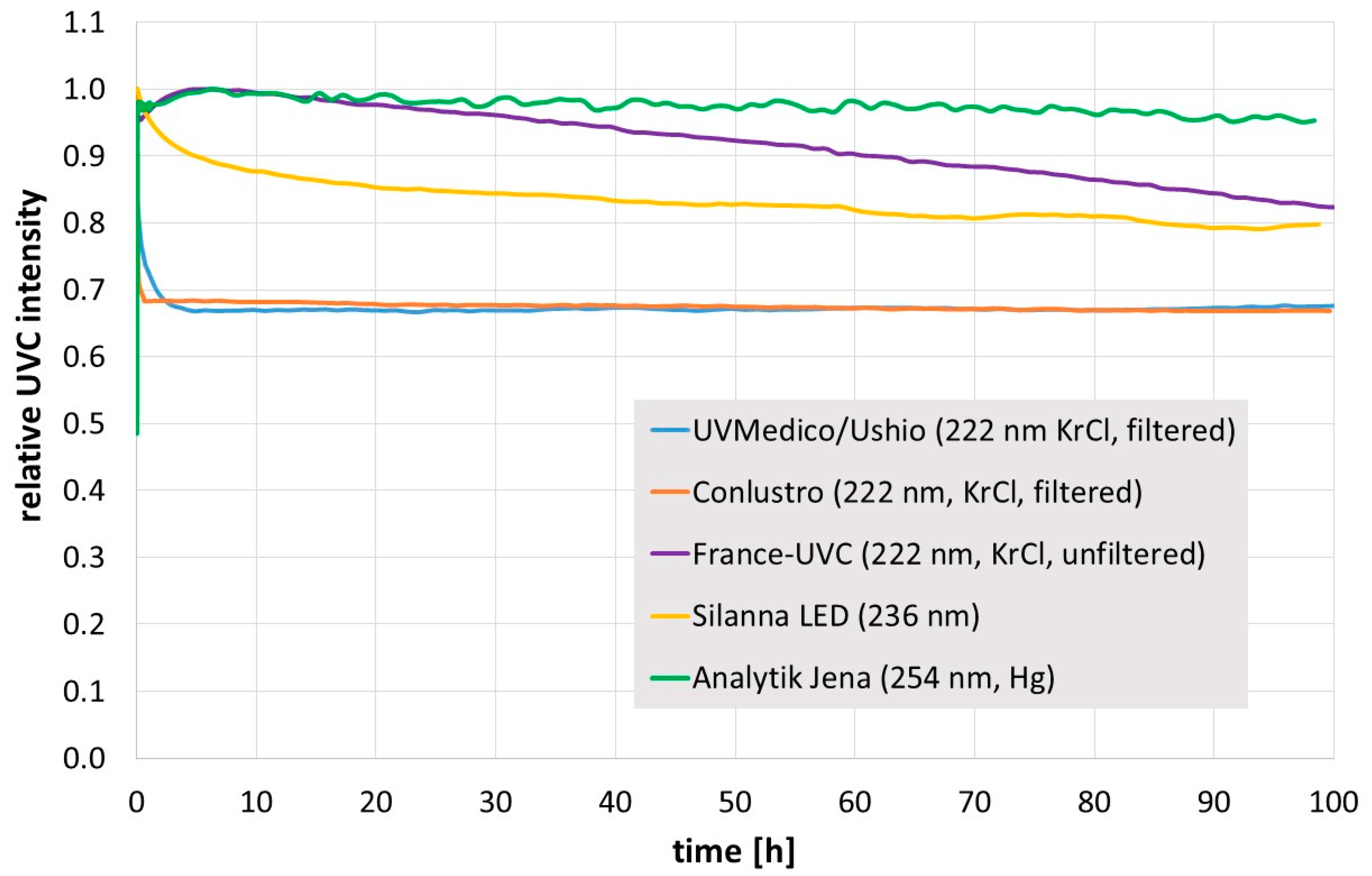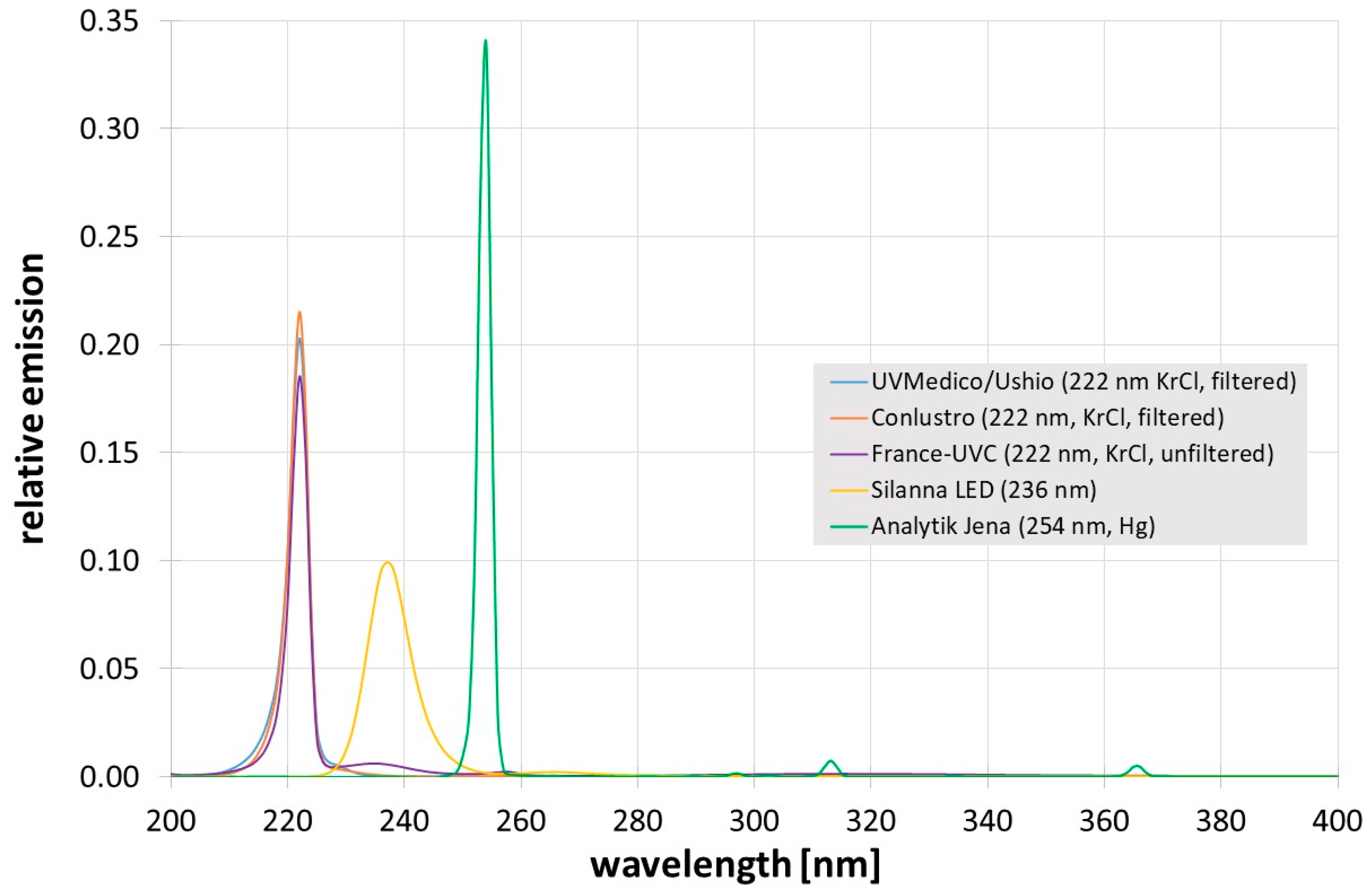Comparison of Different Far-UVC Sources with Regards to Intensity Stability, Estimated Antimicrobial Efficiency and Potential Human Hazard in Comparison to a Conventional UVC Lamp †
Abstract
:1. Introduction
2. Materials and Methods
- A 222 nm KrCl lamp (20 W, filtered), type “UV222” of UVMedico (Aarhus, Denmark), with a KrCl 222 nm module of Ushio (Cypress, CA, USA);
- A 222 nm KrCl lamp (20 W, filtered), type “DF28B” of Conlustro (Sheridan, WY, USA);
- A 222 nm KrCl lamp (5 W, unfiltered), type “DF15B-B1” of France-UVC (Lévignac de Guyenne, France), in combination with a provided electrical converter and a lab power supply at a constant current of 1 A;
- A 236 nm Far-UVC LED (0.3 W, unfiltered), type “SF1 flat lens” of Silanna UV (Pinkenba, Australia), in combination with a lab power supply at a constant current of 40 mA;
- A 254 nm Hg lamp (6 W, unfiltered), type “3UV36” of Analytik Jena (Jena, Germany).
3. Results
4. Discussion
Author Contributions
Funding
Institutional Review Board Statement
Informed Consent Statement
Data Availability Statement
Acknowledgments
Conflicts of Interest
References
- Sosnin, E.A.; Stoffels, E.; Erofeev, M.V.; Kieft, I.E.; Kunts, S.E. The Effects of UV Irradiation and Gas Plasma Treatment on Living Mammalian Cells and Bacteria: A Comparative Approach. IEEE Trans. Plasma Sci. 2004, 32, 1544–1550. [Google Scholar] [CrossRef]
- Buonanno, M.; Randers-Pehrson, G.; Bigelow, A.W.; Trivedi, S.; Lowy, F.D.; Spotnitz, H.M.; Hammer, S.M.; Brenner, D.J. 207-nm UV light-A promising tool for safe low-cost reduction of surgical site infections. I: In vitro studies. PLoS ONE 2013, 8, e76968. [Google Scholar] [CrossRef] [PubMed]
- Buonanno, M.; Stanislauskas, M.; Ponnaiya, B.; Bigelow, A.W.; Randers-Pehrson, G.; Xu, Y.; Shuryak, I.; Smilenov, L.; Owens, D.M.; Brenner, D.J. 207-nm UV Light A Promising Tool for Safe Low-Cost Reduction of Surgical Site Infections. II: In-Vivo Safety Studies. PLoS ONE 2016, 11, e0138418. [Google Scholar] [CrossRef] [PubMed]
- Eadie, E.; Barnard, I.M.R.; Ibbotson, S.H.; Wood, K. Extreme Exposure to Filtered Far-UVC: A Case Study. Photochem. Photobiol. 2021, 97, 527–531. [Google Scholar] [CrossRef] [PubMed]
- Sliney, D.H.; Stuck, B.E. A Need to Revise Human Exposure Limits for Ultraviolet UV-C Radiation. Photochem. Photobiol. 2021, 97, 485–492. [Google Scholar] [CrossRef]
- Buonanno, M.; Welch, D.; Brenner, D.J. Exposure of Human Skin Models to KrCl Excimer Lamps: The Impact of Optical Filtering. Photochem. Photobiol. 2021, 97, 517–523. [Google Scholar] [CrossRef]
- Welch, D.; De Muro, M.A.; Buonanno, M.; Brenner, D.J. Wavelength-dependent DNA Photodamage in a 3-D human Skin Model over the Far-UVC and Germicidal UVC Wavelength Ranges from 215 to 255 nm. Photochem. Photobiol. 2022, 98, 1167–1171. [Google Scholar] [CrossRef]
- Welch, D.; Kleiman, N.J.; Arden, P.C.; Kuryla, C.L.; Buonanno, M.; Ponnaiya, B.; Wu, X.; Brenner, D.J. No Evidence of Induced Skin Cancer or Other Skin Abnormalities after Long-Term (66 week) Chronic Exposure to 222-nm Far-UVC Radiation. Photochem. Photobiol. 2022, 99, 168–175. [Google Scholar] [CrossRef]
- Zwicker, P.; Schleusener, J.; Lohan, S.B.; Busch, L.; Sicher, C.; Einfeldt, S.; Kneissl, M.; Kühl, A.A.; Keck, C.M.; Witzel, C.; et al. Application of 233 nm far-UVC LEDs for eradication of MRSA and MSSA and risk assessment on skin models. Sci. Rep. 2022, 12, 2587. [Google Scholar] [CrossRef]
- Hickerson, R.P.; Conneely, M.J.; Tsutsumi, S.K.H.; Wood, K.; Jackson, D.N.; Ibbotson, S.H.; Eadie, E. Minimal, superficial DNA damage in human skin from filtered far-ultraviolet C. Br. J. Dermatol. 2021, 184, 1197–1199. [Google Scholar] [CrossRef]
- American Conference of Governmental Industrial Hygienists (ACGIH). Threshold Limit Values (TLVs) and Biological Exposure Indices (BEIs): Based on the Documentation of the Threshold Limit Values for Chemical Substances and Physical Agents; ACGIH Publications: Cincinnati, OH, USA, 2022. [Google Scholar]
- Görlitz, M.; Justen, L.; Rochette, P.J.; Buonanno, M.; Welch, D.; Kleiman, N.J.; Eadie, E.; Kaidzu, S.; Bradshaw, W.J.; Javorsky, E.; et al. Assessing the safety of new germicidal far-UVC technologies. Photochem. Photobiol. 2023, 100, 501–520. [Google Scholar] [CrossRef] [PubMed]
- DIN 5031-10: 2018-03; Strahlungsphysik im optischen Bereich und Lichttechnik_-Teil_10: Photobiologisch wirksame Strahlung, Größen, Kurzzeichen und Wirkungsspektren. Beuth Verlag GmbH: Berlin, Germany.
- Malayeri, A.H.; Mohseni, M.; Cairns, B.; Bolton, J.R. Fluence (UV Dose) Required to Achieve Incremental Log Inactivation of Bacteria, Protozoa, Viruses and Algae. IUVA News 2016, 2016, 1–41. [Google Scholar]
- Hessling, M.; Haag, R.; Sieber, N.; Vatter, P. The impact of far-UVC radiation (200–230 nm) on pathogens, cells, skin, and eyes-a collection and analysis of a hundred years of data. GMS Hyg. Infect. Control 2021, 16, Doc07. [Google Scholar] [CrossRef] [PubMed]
- Gierke, A.-M.; Hessling, M. Investigation on Potential ESKAPE Surrogates for 222 and 254 nm Irradiation Experiments. Front. Microbiol. 2022, 13, 942708. [Google Scholar] [CrossRef] [PubMed]
- Lu, Y.H.; Wang, R.X.; Liu, H.L.; Lai, A.C.K. Evaluating the Performance of UV Disinfection across the 222-365 nm Spectrum against Aerosolized Bacteria and Viruses. Environ. Sci. Technol. 2024, 58, 6868–6877. [Google Scholar] [CrossRef]
- Sun, W.; Jing, Z.; Zhao, Z.; Yin, R.; Santoro, D.; Mao, T.; Lu, Z. Dose-Response Behavior of Pathogens and Surrogate Microorganisms across the Ultraviolet-C Spectrum: Inactivation Efficiencies, Action Spectra, and Mechanisms. Environ. Sci. Technol. 2023, 57, 10891–10900. [Google Scholar] [CrossRef]
- Clauss, M.; Springorum, A.C.; Hartung, J. Ultraviolet Disinfection with 222 nm Wavelength–New Options to Inactivate UV-Resistant Pathogens: XIV International Congress of the International Society for Animal Hygiene; International Society for Animal Hygiene: Vechta, Germany, 2009. [Google Scholar]
- O’mahoney, P.; Wood, K.; Ibbotson, S.H.; Eadie, E. Potential harm to the skin from unfiltered krypton chloride ‘far-ultraviolet-C’ lamps, even below an occupational exposure limit. J. Radiol. Prot. 2022, 42, 043501. [Google Scholar] [CrossRef]
- Ivanova, I.; Svilenska, T.; Kurz, B.; Grobecker, S.; Maisch, T.; Berneburg, M.; Kamenisch, Y. Improved Spectral Purity of 222-nm Irradiation Eliminates Detectable Cyclobutylpyrimidine Dimers Formation in Skin Reconstructs even at High and Repetitive Disinfecting Doses. Photochem. Photobiol. 2022, 98, 1149–1156. [Google Scholar] [CrossRef]
- Narita, K.; Asano, K.; Yamane, K.; Ohashi, H.; Igarashi, T.; Nakane, A. Effect of ultraviolet C emitted from KrCl excimer lamp with or without bandpass filter to mouse epidermis. PLoS ONE 2022, 17, e0267957. [Google Scholar] [CrossRef]
- Tavares, R.S.N.; Adamoski, D.; Girasole, A.; Lima, E.N.; Da Justo-Junior, A.D.; Domingues, R.; Silveira, A.C.C.; Marques, R.E.; De Carvalho, M.; Ambrosio, A.L.B.; et al. Different biological effects of exposure to far-UVC (222 nm) and near-UVC (254 nm) irradiation. J. Photochem. Photobiol. B Biol. 2023, 243, 112713. [Google Scholar] [CrossRef]
- Kaidzu, S.; Sugihara, K.; Sasaki, M.; Nishiaki, A.; Ohashi, H.; Igarashi, T.; Tanito, M. Re-Evaluation of Rat Corneal Damage by Short-Wavelength UV Revealed Extremely Less Hazardous Property of Far-UV-C. Photochem. Photobiol. 2021, 97, 505–516. [Google Scholar] [CrossRef] [PubMed]




| UVMedico/Ushio (222 nm KrCl, Filtered) | Conlustro (222 nm KrCl, Filtered) | France-UVC (222 nm, KrCl, Unfiltered) | Silanna LED (236 nm) | Analytik Jena (254 nm Hg) | |
|---|---|---|---|---|---|
| antimicrobial impact (normalized to Analytik Jena lamp) | 0.907 (0.96) | 0.880 (0.93) | 0.826 (0.87) | 0.737 (0.78) | 0.946 (1.0) |
| eye and skin hazard (normalized to filtered UVMedico/Ushio lamp) | 0.019 (1.0) | 0.022 (1.17) | 0.055 (2.9) | 0.247 (13) | 0.475 (25) |
Disclaimer/Publisher’s Note: The statements, opinions and data contained in all publications are solely those of the individual author(s) and contributor(s) and not of MDPI and/or the editor(s). MDPI and/or the editor(s) disclaim responsibility for any injury to people or property resulting from any ideas, methods, instructions or products referred to in the content. |
© 2024 by the authors. Licensee MDPI, Basel, Switzerland. This article is an open access article distributed under the terms and conditions of the Creative Commons Attribution (CC BY) license (https://creativecommons.org/licenses/by/4.0/).
Share and Cite
Sicks, B.; Maiss, F.; Lingenfelder, C.; Wiegand, C.; Hessling, M. Comparison of Different Far-UVC Sources with Regards to Intensity Stability, Estimated Antimicrobial Efficiency and Potential Human Hazard in Comparison to a Conventional UVC Lamp. Phys. Sci. Forum 2024, 10, 1. https://doi.org/10.3390/psf2024010001
Sicks B, Maiss F, Lingenfelder C, Wiegand C, Hessling M. Comparison of Different Far-UVC Sources with Regards to Intensity Stability, Estimated Antimicrobial Efficiency and Potential Human Hazard in Comparison to a Conventional UVC Lamp. Physical Sciences Forum. 2024; 10(1):1. https://doi.org/10.3390/psf2024010001
Chicago/Turabian StyleSicks, Ben, Florian Maiss, Christian Lingenfelder, Cornelia Wiegand, and Martin Hessling. 2024. "Comparison of Different Far-UVC Sources with Regards to Intensity Stability, Estimated Antimicrobial Efficiency and Potential Human Hazard in Comparison to a Conventional UVC Lamp" Physical Sciences Forum 10, no. 1: 1. https://doi.org/10.3390/psf2024010001
APA StyleSicks, B., Maiss, F., Lingenfelder, C., Wiegand, C., & Hessling, M. (2024). Comparison of Different Far-UVC Sources with Regards to Intensity Stability, Estimated Antimicrobial Efficiency and Potential Human Hazard in Comparison to a Conventional UVC Lamp. Physical Sciences Forum, 10(1), 1. https://doi.org/10.3390/psf2024010001





